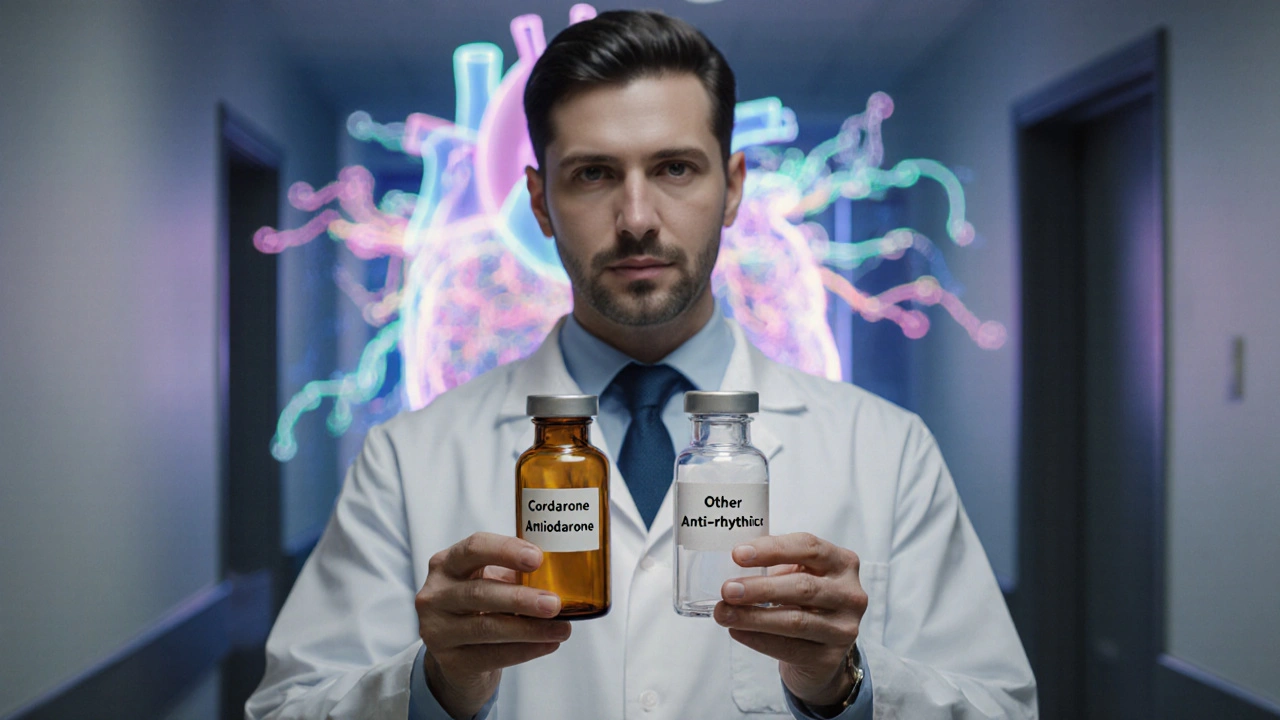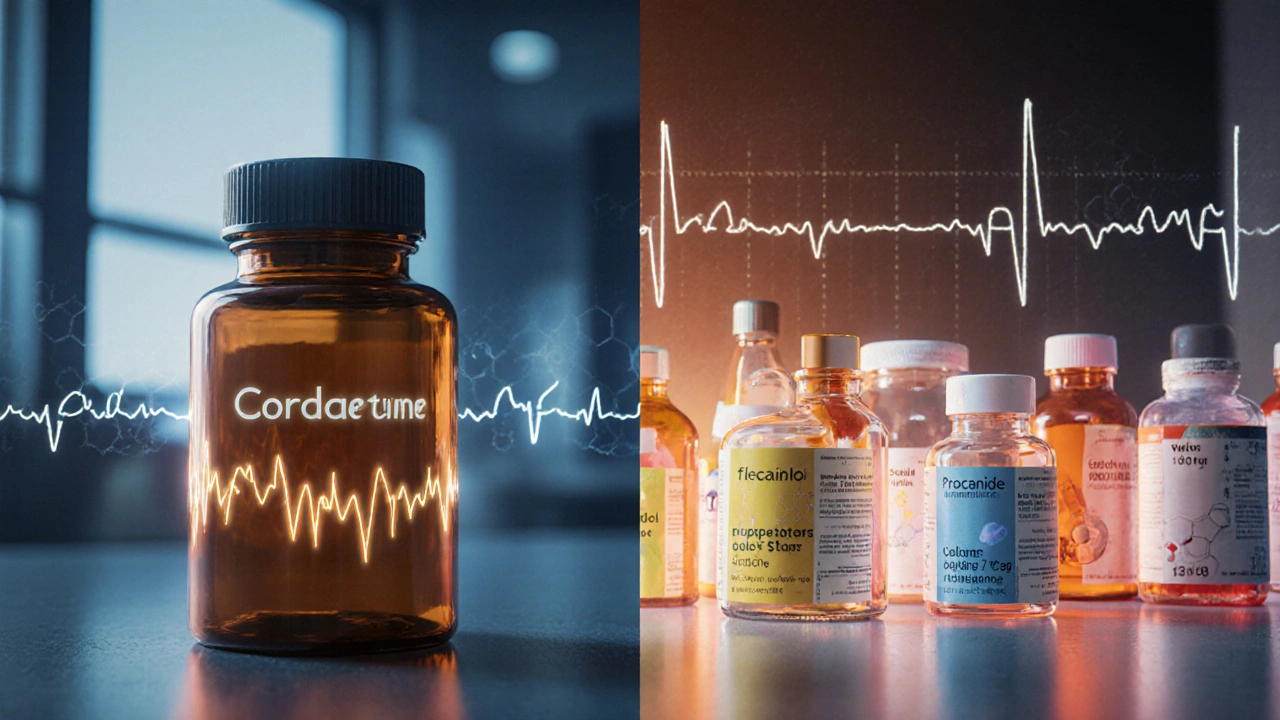Anti-Arrhythmic Drug Selector
Select Patient Conditions
Reason:
Key Takeaways
- Amiodarone is the most potent classIII anti‑arrhythmic but carries the highest long‑term toxicity risk.
- Sotalol and Dofetilide share the classIII action with fewer organ‑specific side effects, yet they need strict QT monitoring.
- Flecainide and Propafenone (classIC) work fast for atrial fibrillation but are unsafe in structural heart disease.
- Beta‑blockers and calcium‑channel blockers are first‑line for rate control; they rarely convert rhythm but have excellent safety profiles.
- Choosing the right drug hinges on the type of arrhythmia, underlying heart condition, and how much monitoring you can handle.
Amiodarone (Cordarone) is a classIII anti‑arrhythmic medication used for life‑threatening ventricular and atrial arrhythmias. Its long half‑life (up to 100days) gives lasting rhythm control but also lets side effects linger for months after stopping.
How Amiodarone Works
Amiodarone blocks potassium channels, prolonging the cardiac action potential and refractory period. It also mildly inhibits sodium, calcium, and beta‑adrenergic receptors, making it a “broad‑spectrum” agent. This multi‑channel effect explains why it can suppress both ventricular tachycardia and atrial fibrillation, but it also means a wide range of organ toxicities.
Major Alternatives Explained
Below are the most common anti‑arrhythmic drugs clinicians consider when Amiodarone isn’t ideal.
Sotalol is a classIII anti‑arrhythmic that also has beta‑blocking properties. It’s often chosen for chronic atrial fibrillation in patients without severe renal impairment.
Dofetilide is a pure classIII potassium‑channel blocker approved for both atrial fibrillation and flutter. Hospital initiation is required because of the risk of torsades de pointes.
Flecainide is a classIC sodium‑channel blocker used mainly for “pill‑in‑the‑pocket” conversion of paroxysmal atrial fibrillation. It must be avoided in coronary artery disease or left‑ventricular dysfunction.
Propafenone is another classIC agent with mild beta‑blocking activity, suitable for rhythm control in structurally normal hearts.
Metoprolol is a selective beta‑1 blocker that manages rate in atrial fibrillation and reduces sudden cardiac death post‑myocardial infarction.
Diltiazem is a non‑dihydropyridine calcium‑channel blocker often used for rate control in atrial fibrillation and flutter.
Digoxin is a cardiac glycoside that slows ventricular response through vagal stimulation, useful when beta‑blockers are contraindicated.

Side‑Effect Profiles at a Glance
| Drug | Mechanism | Typical Dose | Major Side Effects | Best Use Case |
|---|---|---|---|---|
| Amiodarone | ClassIII (K⁺ block) + Na⁺, Ca²⁺, β‑block | 200mg‑400mg daily (loading), then 100mg maintenance | Pulmonary fibrosis, thyroid dysfunction, liver toxicity, skin photosensitivity | Life‑threatening ventricular tachycardia/fibrillation |
| Sotalol | ClassIII (K⁺) + β‑block | 80‑160mg twice daily | QT prolongation → torsades, fatigue | Chronic atrial fibrillation in patients with normal renal function |
| Dofetilide | ClassIII (K⁺) | 125‑500µg twice daily (renal‑adjusted) | Torsades, renal clearance issues | Atrial fibrillation/flutter when Amiodarone is contraindicated |
| Flecainide | ClassIC (Na⁺) | 100‑200mg single dose or 50‑100mg twice daily | Pro‑arrhythmia in structural heart disease | Pill‑in‑the‑pocket conversion of paroxysmal AF |
| Propafenone | ClassIC (Na⁺) + β‑block | 150‑300mg twice daily | Bradycardia, pro‑arrhythmia in CAD | Rhythm control in patients without CAD |
| Metoprolol | β‑1 blocker | 25‑200mg daily | Hypotension, fatigue, bronchospasm | Rate control in AF, post‑MI mortality reduction |
| Diltiazem | Ca²⁺ channel blocker (L‑type) | 120‑360mg daily | Constipation, edema, AV block | Rate control in AF/flutter when β‑blockers unsuitable |
| Digoxin | Cardiac glycoside | 0.125‑0.25mg daily | Arrhythmia, GI upset, visual disturbances | Rate control in AF with heart failure, when other agents fail |
Choosing the Right Anti‑arrhythmic
When you or your cardiologist weigh options, think of three practical axes:
- Efficacy for the specific rhythm problem. Ventricular tachycardia usually demands Amiodarone or an implanted device. Atrial fibrillation often responds to rate‑control agents first, then rhythm‑control drugs.
- Safety & monitoring burden. Amiodarone needs baseline liver, thyroid, and pulmonary tests plus follow‑up every 3‑6months. Sotalol and Dofetilide require daily ECGs for the first 2‑3weeks.
- Patient comorbidities. Structural heart disease rules out classIC drugs. Renal impairment limits Sotalol & Dofetilide. Chronic lung disease makes Amiodarone risky.
In practice, many clinicians start with a beta‑blocker or diltiazem for rate control, add a classIII drug if rhythm conversion fails, and reserve Amiodarone for the sickest patients.
Managing Amiodarone’s Long‑Term Toxicities
If Amiodarone is the only viable choice, proactive monitoring can catch problems early:
- Baseline chest X‑ray, liver enzymes (ALT/AST), thyroid panel (TSH, free T4), and ECG.
- Repeat labs every 6months; pulmonary function tests if you develop cough or dyspnea.
- Consider switching to a lower maintenance dose (50‑100mg) once rhythm is stable.
- Educate patients to report photosensitivity or skin discoloration promptly.
Frequently Asked Questions
Can I stop Amiodarone abruptly?
Because of its long half‑life, stopping suddenly can cause rebound arrhythmias. Tapering under a doctor’s supervision is recommended.
Is Sotalol safer than Amiodarone for atrial fibrillation?
Sotalol has fewer organ‑specific toxicities but carries a higher risk of QT‑prolongation. It’s safer for short‑term use if kidney function is good.
When is Flecainide preferred over Amiodarone?
In patients with normal hearts who need rapid conversion of a single episode of AF, Flecainide works fast and avoids Amiodarone’s long‑term side effects.
Do beta‑blockers replace anti‑arrhythmics?
Beta‑blockers control heart rate but do not usually restore normal rhythm. They’re first‑line for rate control; rhythm‑control drugs may still be needed.
What monitoring is required for Dofetilide?
Hospital admission for at least 3days with QT monitoring every 12hours. Dose is adjusted to creatinine clearance.
In short, Amiodarone remains the heavyweight champion for high‑risk ventricular arrhythmias, but a basket of safer, more targeted drugs exists for most atrial fibrillation scenarios. Matching the drug’s strengths to the patient’s heart condition, comorbidities, and ability to stay under surveillance is the key to a successful rhythm strategy.

Amiodarone’s toxicity profile is undeniable, but its efficacy remains unmatched.
From the Indian perspective, cost is a decisive factor, and generic amiodarone provides a budget‑friendly option for patients who need aggressive rhythm control. The drug’s multi‑channel blockade makes it a universal antidote for both ventricular and atrial tachyarrhythmias. Yet the same potency brings a spectrum of organ‑specific toxicities that demand vigilant monitoring, something not always feasible in resource‑limited settings. Therefore, clinicians must balance the immediate life‑saving benefits against the long‑term risk of pulmonary fibrosis, thyroid dysfunction and hepatic injury. In practice, we often reserve amiodarone for life‑threatening cases and turn to sotalol or dofetilide when monitoring capacity is moderate.
Sometimes you just need a pill that works. Amiodarone does that, but it feels like a double‑edged sword.
Wow, the table is packed with data, and the side‑effect column is scary, especially the lung stuff; still, the efficacy numbers are impressive. Keep monitoring, stay safe.
When evaluating anti‑arrhythmic therapy, it is essential to adopt a systematic framework that integrates electrophysiological principles, pharmacokinetic considerations, and patient‑specific factors. Amiodarone, as a class III agent with ancillary sodium, calcium, and β‑adrenergic blockade, offers unparalleled efficacy in both ventricular tachyarrhythmias and refractory atrial fibrillation. Its long half‑life, which can exceed 100 days, ensures sustained rhythm control but simultaneously predisposes to cumulative organ toxicity. The most clinically significant adverse events include pulmonary fibrosis, thyroid dysfunction-both hypo‑ and hyper‑thyroidism-and hepatocellular injury; these necessitate baseline and periodic laboratory surveillance. In contrast, sotalol combines class III potassium channel inhibition with β‑blockade, delivering a more favorable side‑effect profile, albeit with a heightened risk of QT prolongation and torsades de pointes. Dofetilide, a pure potassium channel blocker, mandates inpatient initiation with continuous electrocardiographic monitoring for at least three days to mitigate the same pro‑arrhythmic risk. For patients with structurally normal hearts, class IC agents such as flecainide and propafenone provide rapid conversion of paroxysmal atrial fibrillation, but they are contraindicated in coronary artery disease or left‑ventricular dysfunction due to pro‑arrhythmic potential. β‑blockers like metoprolol and non‑dihydropyridine calcium‑channel blockers such as diltiazem remain first‑line for rate control, offering excellent safety and tolerability. Digoxin can be added in heart‑failure patients when other agents are insufficient, though its narrow therapeutic index requires careful dosing. The choice among these agents should be anchored to three practical axes: efficacy for the targeted rhythm disorder, the safety and monitoring burden, and any comorbid conditions that may amplify drug toxicity. For instance, a patient with chronic lung disease would benefit from avoiding amiodarone’s pulmonary side effects, while one with renal impairment would need dose adjustments for sotalol or avoidance of dofetilide. Moreover, the availability of robust follow‑up infrastructure often dictates whether a high‑monitoring drug is feasible. Ultimately, a shared decision‑making process, wherein clinicians present the risk‑benefit matrix and patients voice their preferences, leads to optimal therapeutic alignment. Regular re‑assessment of drug efficacy and toxicity should be performed at least every six months, and any emerging side effects warrant prompt dose reduction or drug substitution. By adhering to this structured approach, clinicians can harness the full therapeutic potential of anti‑arrhythmic agents while minimizing harm.
The QT interval prolongation associated with class III agents such as sotalol and dofetilide remains a pivotal safety concern, especially in patients with baseline electrolyte disturbances. Rigorous electrolyte correction and daily ECG monitoring during the initiation phase can substantially mitigate the risk of torsades de pointes. Moreover, dose titration based on creatinine clearance is indispensable for dofetilide, as renal impairment directly amplifies plasma concentrations. While amiodarone exhibits a comparatively lower propensity for QT‑mediated arrhythmias, its multi‑system toxicity profile often overshadows this benefit.
Great points on monitoring the QT and adjusting doses; staying proactive can really protect patients.
Wow, that was a novel‑length dissertation for a drug table-who knew anti‑arrhythmics required a PhD?
Indeed, the data presented is most illuminating; however, one must not overlook the subtle nuances of pharmacodynamic interactions that remain unaddressed-truly, a lamentable omission.
While the eloquence of the previous remark is appreciated, the clinical reality dictates that any omission of drug‑interaction screening could precipitate catastrophic events, especially in polypharmacy scenarios.
i think its important to be more honest about the reall risk of these meds, not just the fancy talk.
We all agree that transparency is key; patients deserve clear explanations of both benefits and potential harms, and clinicians have an ethical duty to provide them.
Ah, the moral high ground-so comforting-while the real world demands clinicians juggle dosage regimens, monitoring protocols, and insurance constraints, all without a crystal ball.
In the end, medicine is just a game of risk vs reward; you pick the card that looks best and hope you don't lose.